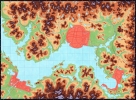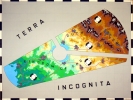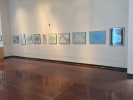Nanogeography
Venue: Constance Gallery, Graceland University
Dates: January 18th – February 12th, 2016
[tabby title=”Statement”]
The works in “Nanogeography” come from my “Maps” series, which combines the visual languages of electronic design and maps. The starting point for most of the works is found in the shapes and contours of printed circuit boards and other electronic components; by adding a topographic layer on top of them, I transformed them into maps. These electronic components can become topological maps, detailed city plans, sky maps, or nighttime satellite views; the transformation process consists of selecting and enlarging relevant details, letterpress printing entire circuit boards, and finalizing the map with drawing or painting. Alternatively, maps can be the starting point of digital modifications using my own custom-written software; these map modifications are inspired by typical operations in electronic design software.
For example, in “Untitled (Rift Valley)” and “Untitled (Volcanic Island),” the wire shapes found on circuit boards are a source of inspiration for both the map outlines and the topological features represented in the map; in “Map of the Curiously Shaped, Two-Sided Flat World MIC1640A,” all the wires on the entire circuit board become a world map. In others, such as “RCA City,” and “Cities in a Deep Valley,” entire circuit boards are letterpress printed; these shapes become city plans, which, in turn, suggest the topology of the rest of the map. The same circuit boards printed in gray suggest scientific maps of the night sky, a technique used in “Black Hole Sun Explosion (with Restart)” and “Even Engineers Need to Know the Future.” Alternatively, when looking from above, prints of the same boards may allude to nighttime satellite photos of urban centers, as in “Nighttime Satellite View #2 (By the Sea).” This type of view is further explored in “Flight Marker (Manila)” and “Flight Marker (Brasilia)” – digital works based on high-resolution images of cities at night taken from the International Space Station. Here, using my own custom software, the flight path of the station is used to stretch night views of large cities. Finally, inspired by typical computer manipulations of circuit boards, images of maps are stretched manually (in “Stretched Wire, Extrapolated Map”) and using my custom software (in “Waterfall (Saint Helena)” and “Swoosh (Sardinia)”).
In the process, these works blur the boundaries between the man-made and the natural, reimagining the tiniest of engineered components as vast landmasses. They also illuminate the connections between the ancient art of mapmaking and the very contemporary art of electronic design and of software algorithms. This is a constant theme in my practice: repurposing and re-contextualizing old technological products to uncover connections between new and old technologies.
[tabby title=”Selected Works” open=”yes”]
[tabby title=”Exhibition Images”]
[tabbyending]
























